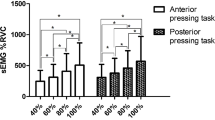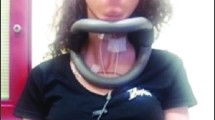Abstract
The purpose of this study was to confirm the effect of effortful swallowing (ES) exercise programs applied to increase the swallowing-related muscle strength in the elderly. In this study, 20 healthy elderly people (76.65 ± 5.87 years; 10 women and 10 men) participated and exercised for 7 weeks. The experimental group performed ES exercise combined with external resistance using Iowa Oral Performance Instrument (IOPI), and the control group performed pure ES without external resistance. The exercises were performed for 20 min a day, 2 days a week for 7 weeks in both groups. ES was repeated 60 times in weeks 1 and 2, 80 times in week 3 and 4, and 120 times in weeks 5–7. In the experimental group, the isometric and swallowing tongue pressures at week 8 were significantly improved compared to baseline. At week 8, the anterior and swallowing tongue pressures and anterior tongue endurance were significantly higher than those of the control group. In the control group, no significant change in tongue pressure-related variables was observed after 7 weeks of exercise. ES exercise combined with IOPI resistance for 7 weeks tended to increase the suprahyoid muscle activation level without statistical significance. For clinical application of this exercise protocol, further studies including more elderly people and patients with dysphagia are required.
Similar content being viewed by others
References
Pouderoux P, Kahrilas PJ. Deglutitive tongue force modulation by volition, volume, and viscosity in humans. Gastroenterology. 1995;108:1418–26.
Hiss SG, Huckabee ML. Timing of pharyngeal and upper esophageal sphincter pressures as a function of normal and effortful swallowing in young healthy adults. Dysphagia. 2005;20:149–56.
Slovarp L, King L, Off C, Liss J. A pilot study of the tongue pull-back exercise for improving tongue-base retraction and two novel methods to add resistance to the tongue pull-back. Dysphagia. 2016;31:416–23.
Burkhead LM, Sapienza CM, Rosenbek JC. Strength-training exercise in dysphagia rehabilitation: principles, procedures, and directions for future research. Dysphagia. 2007;22:251–65.
Clark HM, Shelton N. Training effects of the effortful swallow under three exercise conditions. Dysphagia. 2014;29:553–63.
Park J, Hong H, Nam K. Comparison of three exercises on increasing tongue strength in healthy young adults. Arch Oral Biol. 2020;111:104636.
Park T, Kim Y. Effects of tongue pressing effortful swallow in older healthy individuals. Arch Gerontol Geriatr. 2016;66:127–33.
Oh J-C. Systematic effortful swallowing exercise without external resistance does not increase swallowing-related muscle strength in the elderly. Dysphagia. 2020; online ahead of print.
Kim H, Park J-W, Nam K. Effortful swallow with resistive electrical stimulation training improves pharyngeal constriction in patients post-stroke with dysphagia. J Oral Rehabil. 2017;44:763–9.
Park JW, Kim Y, Oh JC, Lee HJ. Effortful swallowing training combined with electrical stimulation in post-stroke dysphagia: a randomized controlled study. Dysphagia. 2012;27:521–7.
Park JW, Oh JC, Lee HJ, Park SJ, Yoon TS, Kwon BS. Effortful swallowing training coupled with electrical stimulation leads to an increase in hyoid elevation during swallowing. Dysphagia. 2009;24:296–301.
Park J-S, Oh D-H, Hwang N-K, Lee J-H. Effects of neuromuscular electrical stimulation combined with effortful swallowing on post-stroke oropharyngeal dysphagia: a randomised controlled trial. J Oral Rehabil. 2016;43:426–34.
Chen YW, Chang KH, Chen HC, Liang WM, Wang YH, Lin YN. The effects of surface neuromuscular electrical stimulation on post-stroke dysphagia: a systemic review and meta-analysis. Clin Rehabil. 2016;30:24–35.
Tan C, Liu Y, Li W, Liu J, Chen L. Transcutaneous neuromuscular electrical stimulation can improve swallowing function in patients with dysphagia caused by non-stroke diseases: a meta-analysis. J Oral Rehabil. 2013;40:472–80.
Beckmann Y, Gurgor N, Cakir A, Arici S, Incesu TK, Secil Y, et al. Electrophysiological evaluation of dysphagia in the mild or moderate patients with multiple sclerosis: a concept of subclinical dysphagia. Dysphagia. 2015;30:296–303.
Shaker R, Kern M, Bardan E, Taylor A, Stewart ET, Hoffmann RG, et al. Augmentation of deglutitive upper esophageal sphincter opening in the elderly by exercise. Am J Physiol. 1997;272:G1518–22.
Hiramatsu T, Kataoka H, Osaki M, Hagino H. Effect of aging on oral and swallowing function after meal consumption. Clin Interv Aging. 2015;10:229–35.
Huckabee ML, Steele CM. An analysis of lingual contribution to submental surface electromyographic measures and pharyngeal pressure during effortful swallow. Arch Phys Med Rehabil. 2006;87:1067–72.
Clark HM, Solomon NP. Age and sex differences in orofacial strength. Dysphagia. 2012;27:2–9.
Youmans SR, Stierwalt JAG. Measures of tongue function related to normal swallowing. Dysphagia. 2006;21:102–11.
Oh JC. Effect of the head extension swallowing exercise on suprahyoid muscle activity in elderly individuals. Exp Gerontol. 2018;110:133–8.
Kays SA, Hind JA, Gangon RE, Robbins J. Effects of dining on tongue endurance and swallowing-related outcomes. Dysphagia. 2011;26:201.
Adams V, Mathisen B, Baines S, Lazarus C, Callister R. Reliability of measurements of tongue and hand strength and endurance using the Iowa Oral Performance Instrument with healthy adults. Dysphagia. 2014;29:83–95.
Clark HM. Specificity of training in the lingual musculature. J Speech Lang Hear Res. 2012;55:657.
Bülow M, Olsson R, Ekberg O. Videomanometric analysis of supraglottic swallow, effortful swallow, and chin tuck in healthy volunteers. Dysphagia. 1999;72:67–72.
Robbins J, Gangnon RE, Theis SM, Kays SA, Hewitt AL, Hind JA. The effects of lingual exercise on swallowing in older adults. J Am Geriatr Soc. 2005;53:1483–9.
Portney LG, Watkins MP. Foundations of clinical research: applications to practice. Upper Saddle River, NJ: Prentice Hall; 2000.
Molfenter SM, Hsu CY, Lu Y, Lazarus CL. Alterations to swallowing physiology as the result of effortful swallowing in healthy seniors. Dysphagia. 2018;33:380–8.
Yoshida M, Groher ME, Crary MA, Mann GC, Akagawa Y. Comparison of surface electromyographic (sEMG) activity of submental muscles between the head lift and tongue press exercises as a therapeutic exercise for pharyngeal dysphagia. Gerodontology. 2007;24:111–6.
Yano J, Yamamoto-Shimizu S, Yokoyama T, Kumakura I, Hanayama K, Tsubahara A. Effects of anterior tongue strengthening exercises on posterior tongue strength in healthy young adults. Arch Oral Biol. 2019;98:238–42.
Van den Steen L, Schellen C, Verstraelen K, Beeckman AS, Vanderwegen J, De Bodt M, et al. Tongue-strengthening exercises in healthy older adults: specificity of bulb position and detraining effects. Dysphagia. 2018;33:337–44.
Oh J-C, Park J-W, Cha T-H, Woo H-S, Kim D-K. Exercise using tongue-holding swallow does not improve swallowing function in normal subjects. J Oral Rehabil Engl. 2012;39:364–9.
Kraemer WJ, Adams K, Cafarelli E, Dudley GA, Dooly C, Feigenbaum MS, et al. Progression models in resistance training for healthy adults. Med Sci Sports Exerc. 2002;34:364–80.
Kim SJ, Han TR. Effect of surface electrical stimulation of suprahyoid muscles on hyolaryngeal movement. Neuromodulation. 2009;12:134–40.
Humbert IA, Michou E, MacRae PR, Crujido L. Electrical stimulation and swallowing: how much do we know? Semin Speech Lang. 2012;33:203–16.
Archer SK, Smith CH, Newham DJ. Surface electromyographic biofeedback and the effortful swallow exercise for stroke-related dysphagia and in healthy ageing. Dysphagia. 2020; online ahead of print.
Smaoui S, Langridge A, Steele CM. The effect of lingual resistance training interventions on adult swallow function: a systematic review. Dysphagia. 2020;35:745–61.
Robbins J, Kays SA, Gangnon RE, Hind JA, Hewitt AL, Gentry LR, et al. The effects of lingual exercise in stroke patients with dysphagia. Arch Phys Med Rehabil. 2007;88:150–8.
Acknowledgements
The author would like to acknowledge the support of So-Yeon Park, Kyung-Hee Kang, Na-Rae Kim, Ji-Hyeon Kim, So-Jeong Lee, and Se-Jin Han.
Funding
This work was supported by the National Research Foundation of Korea (NRF) grant funded by the Korea government (MSIT) (No. NRF-2017R1C1B5017285). Role of the Funding Source The funding source was not involved in the study design; the collection, analysis, and interpretation of the data; the writing of the report; or in the decision to submit the article for publication.
Author information
Authors and Affiliations
Corresponding author
Ethics declarations
Conflict of interest
The author declares that there are no competing interests.
Ethical Approval and Consent to Participate
All procedures performed in this study were in accordance with the ethical standards of the institutional and/or national research committees and the 1964 Helsinki declaration and its later amendments or comparable ethical standards. All the participants provided informed consent to participate in this study. The protocol was approved by the ethics committee of Institutional Review Board of Cheongju University (1041107-202004-HR-009-01).
Additional information
Publisher's Note
Springer Nature remains neutral with regard to jurisdictional claims in published maps and institutional affiliations.
Rights and permissions
About this article
Cite this article
Oh, JC. Effects of Effortful Swallowing Exercise with Progressive Anterior Tongue Press Using Iowa Oral Performance Instrument (IOPI) on the Strength of Swallowing-Related Muscles in the Elderly: A Preliminary Study. Dysphagia 37, 158–167 (2022). https://doi.org/10.1007/s00455-021-10259-7
Received:
Accepted:
Published:
Issue Date:
DOI: https://doi.org/10.1007/s00455-021-10259-7




